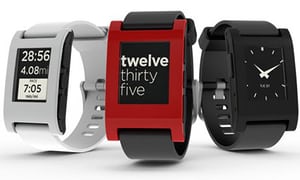
This year, Google Glass may be garnering headlines as a cyborg oddity and a privacy threat. But, just as tablet computers have turned the PC market on its head, I believe wearable devices of various kinds will become a disruptive, revolutionary and huge future industry category. Here’s why.
Familiarity will feed interest
Look at data for consumer purchase intent today, and you’d be hard-pressed to find a wearable device boom waiting to happen. Only around four in 10 want to buy one, according to Opinion Research Corp.
But that’s because most consumers haven’t yet heard of the gadgets, according to SurveyMonkey. Once upon a time, people didn’t think they needed a moving picture box in their living room either — but now TVs are part of our everyday lives. As these new devices show themselves on friends’ wrists and temples in 2014, interest in wearables will exceed current indications.
The ultimate tech fashion accessory
In 2013, tech is hip. Having the right mobile phone is essential social currency, t-shirts sporting “GEEK” are the season’s hot teen item — technology and technology culture are now mass-market fashion consumables.
Wearable gadgets are the logical next step and the ultimate embodiment of this trend. Trading on the established fashion status of conventional watches, I predict a multi-purpose smartwatch from a company like Apple will fly off the shelves — priced sensibly, at £70 to £90, it would enter both the desirability realm and the gift segment, just like its forebear.
Genuine utility for today’s generation
Appetite for wearables will emerge not from the long, esoteric dreams of “smart clothes” fashion school hackers but as solutions to the genuine (or, at least, perceived) needs of digital-generation consumers.
Health-tracking, self-quantifying bracelets will empower individual patients to monitor and respond to their own changing bodies — a boon in countries where public health systems are struggling to cope with the demands of such routine matters.
Meanwhile, always-on-body devices that show us live information will satisfy the urge of many to cram even more information in to their lives. I saw this first-hand recently when I noticed a non-techy friend sporting a Pebble smartwatch, something she loves for granting her the ability to see SMS and other alerts whilst dashing on and off buses, absolving her of the first-world problem of having to reach in to her handbag for her phone. This generation’s desire for constant streams of information is growing, and is something that can be satisfied further by bringing that information closer still.
We are already cyborgs
Reticence toward wearable technology centres on the “technology” piece of that equation — will consumers really want to enhance their bodies with gadgets? But our peculiar understanding of “technology” is often grounded by our own place in temporality…
When, in 1904, aviator Alberto Santos-Dumont asked Louis Cartier to grant him the ability to tell the time whilst keeping both hands on his plane’s controls, he may have marvelled at Cartier’s innovation of strapping a clock to his wrist.
But, so much has the wristwatch become part of our bodies that, today, nobody regards its special powers with either marvel or techno-suspicion — for everyone, the inhuman ability to tell time by glancing at a limb is second nature. This acceptance suggests that, in years ahead, consumers will similarly accept a new range of augmentations.
The wrists, not the eyes, have it
The most seemingly supernatural of such enhancements are promised to beam directions and ambient people look-ups direct to eyeballs from heads-up displays like Google Glass. But research so far shows consumers prefer the idea of clip-on or strap-on devices over spectacles.
Whilst eye-mounted augmentations may, in time, gain favour just as the wristwatch did, more familiar gadgets will clearly have the edge over more outlandish alternatives. That means easy-to-comprehend apps like fitness tracking and notifications will win out in early days.
As big as mobile?
Bolting hardware to bodies instead of in portable plastic slabs could conceivably make for an industry that is bigger than even mobile as we know it today. But will this really come to pass?
Despite some individual anomalies, analysts’ forecasts for wearable device shipments have reached broad consensus at least on a consistent growth pattern — to 171 million in 2016, according to IMS. This could make wearables about a tenth the size of this year’s smartphone market, forecast by IHS to hit a billion shipments.
Could wearables really become such a large part in such a short space of time? Consider that, in 2002, only just over 40 million smartphones were shipped (ARC), and it’s clear wearables would need to boom significantly to match this pace.
But judging the popularity of a device category that barely yet exists is fraught. Just don’t be surprised if, in 10 years time, your bifocals, smartwatch or cochlear computer beep to alert you to greater-than-expected wearable sales.